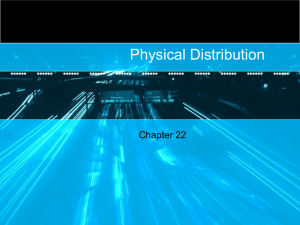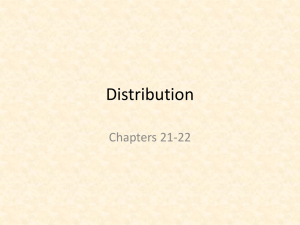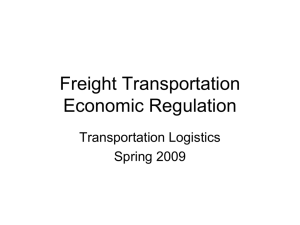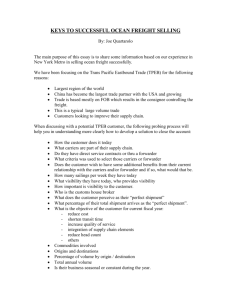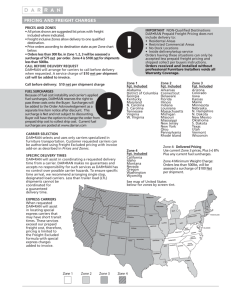Chapter 22 Section 22.1
advertisement
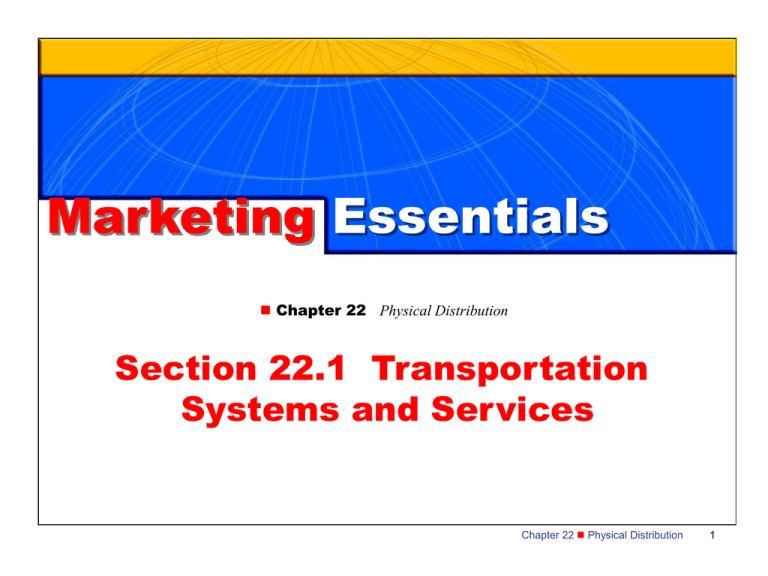
Marketing Essentials n Chapter 22 Physical Distribution Section 22.1 Transportation Systems and Services Chapter 22 n Physical Distribution 1 SECTION 22.1 Transportation Systems and Services What You'll Learn The nature and scope of physical distribution How transportation systems are used to move products The different kinds of transportation services Chapter 22 n Physical Distribution 2 SECTION 22.1 Transportation Systems and Services Why It's Important To gain a competitive advantage and succeed in today's business environment, you will want to learn how businesses are delivering products to buyers around the country and the world. Chapter 22 n Physical Distribution 3 SECTION 22.1 Transportation Systems and Services Key Terms physical distribution exempt carrier transportation ton-mile common carrier carload private carrier freight forwarders Chapter 22 n Physical Distribution 4 SECTION 22.1 Transportation Systems and Services The Nature and Scope of Physical Distribution Physical distribution, also known as logistics, comprises all the activities that help to ensure that the right amount of product is delivered to the right place at the right time. Between 20 to 25 percent of the value of a product can be assigned to physical distribution expenses. Chapter 22 n Physical Distribution 5 SECTION 22.1 Transportation Systems and Services Types of Transportation Transportation is the marketing function of moving products from a seller to a buyer. There are five major transportation forms that move products: motor carriers railroads waterways pipelines air carriers Chapter 22 n Physical Distribution 6 SECTION 22.1 Trucking Transportation Systems and Services Trucks (or motor carriers) are the most frequently used form of transportation. They carry higher-valued products that are expensive to carry in inventory. Businesses use trucks for virtually all intracity (within a city) shipping and for 26 percent of the intercity (between cities) freight traffic in the United States. Chapter 22 n Physical Distribution 7 SECTION 22.1 Transportation Systems and Services Types of Carriers Businesses that use trucks to move their products can use: for-hire carriers private carriers a combination of both Slide 1 of 4 Chapter 22 n Physical Distribution 8 SECTION 22.1 Transportation Systems and Services Types of Carriers For-hire carriers include common carriers and contract carriers. Common carriers provide transportation services to any business in its operating area for a fee. A contract carrier provides equipment and drivers for specific routes, according to agreements with the shipper. Slide 2 of 4 Chapter 22 n Physical Distribution 9 SECTION 22.1 Transportation Systems and Services Types of Carriers Private carriers transport goods for an individual business. Starting a private carrier fleet can require significant capital, but a business that regularly ships a large amount of merchandise may like the flexibility of owning its own means of transporting its products. Slide 3 of 4 Chapter 22 n Physical Distribution 10 SECTION 22.1 Transportation Systems and Services Types of Carriers Exempt carriers, which commonly carry agricultural products, are free from direct regulation of rates and operating procedures. Exempt carrier status can also be granted to local transportation firms that make short-distance deliveries within specified trading areas in cities. Slide 4 of 4 Chapter 22 n Physical Distribution 11 SECTION 22.1 Transportation Systems and Services Advantages and Disadvantages of Truck Transportation Advantages door-to-door delivery reduced packaging costs for some products rapid deliveries Disadvantages susceptibility to delays due to traffic jams, equipment breakdowns, and traffic accidents size and weight restrictions enforced by states Chapter 22 n Physical Distribution 12 SECTION 22.1 Transportation Systems and Services Physical Distribution Physical distribution involves the functions of: order processing transportation storage stock handling inventory control Slide 1 of 4 Chapter 22 n Physical Distribution 13 SECTION 22.1 Transportation Systems and Services Physical Distribution Order Processing The purchase of a product initiates the movement of products through a physical distribution system. Transportation Transportation involves the actual physical movement of products. It is estimated that up to 8 percent of a company's sales are spent on the transportation function. Slide 2 of 4 Chapter 22 n Physical Distribution 14 SECTION 22.1 Transportation Systems and Services Physical Distribution Storage The storage function facilitates the actual movement of products through the distribution channel as products are sold. Stock Handling Receiving, checking, and marking items for sale are an important step in the physical distribution system. Slide 3 of 4 Chapter 22 n Physical Distribution 15 SECTION 22.1 Transportation Systems and Services Physical Distribution Inventory Control Proper inventory control ensures that products are kept in sufficient quantities and available when requested by customers. Slide 4 of 4 Chapter 22 n Physical Distribution 16 SECTION 22.1 Transportation Systems and Services Rail Transportation Trains transport nearly 38 percent of the total intercity ton-miles (the movement of one ton of freight one mile) of freight. Trains are important for moving heavy and bulky freight, such as coal, steel, lumber, chemicals, grain, farm equipment, and automobiles, over long distances. Chapter 22 n Physical Distribution 17 SECTION 22.1 Transportation Systems and Services Rail Pricing and Delivery Systems Railroads offer several specialized and innovative pricing and delivery services, including: piggyback service fishyback service specialized service package arrangements diversion-in-transit processing-in-transit Slide 1 of 4 Chapter 22 n Physical Distribution 18 SECTION 22.1 Transportation Systems and Services Rail Pricing and Delivery Systems Piggyback service gets its name from carrying (piggybacking) loaded truck trailers over land on railroad flatcars. Fishyback service is shipping loaded truck trailers over water on ships and barges. Slide 2 of 4 Chapter 22 n Physical Distribution 19 SECTION 22.1 Transportation Systems and Services Rail Pricing and Delivery Systems Specialized service involves transporting items such as milk, fresh vegetables, or hazardous materials in specially designed freight cars. Package (or pool) arrangements allow several shippers who are sending their items to a common destination to combine their items to fill an entire carload (the amount required to fill a boxcar). Slide 3 of 4 Chapter 22 n Physical Distribution 20 SECTION 22.1 Transportation Systems and Services Rail Pricing and Delivery Systems Diversion-in-transit service allows the redirection of carloads already en route. Processing-in-transit permits shippers to have products processed, repackaged, and assembled while in transit to their final destination. Slide 4 of 4 Chapter 22 n Physical Distribution 21 SECTION 22.1 Transportation Systems and Services Advantages and Disadvantages of Rail Transportation Advantages relatively low costs handle large quantities seldom slowed or stopped by bad weather Disadvantages lack of flexibility—pick up and delivery available only at established stations Chapter 22 n Physical Distribution 22 SECTION 22.1 Transportation Systems and Services Water Transportation Shipment over water is one of the oldest methods of transporting merchandise. The United States Maritime Commission regulates U.S. water transportation. Chapter 22 n Physical Distribution 23 SECTION 22.1 Transportation Systems and Services Internal and Intracoastal Waterways Internal shipping is shipping from one port to another on connecting rivers and lakes. The St. Lawrence Seaway, the Mississippi and Ohio rivers, and the Great Lakes are important internal shipping routes. Intracoastal shipping is shipping between ports along the Atlantic or Pacific coasts or from one coast to the other. Chapter 22 n Physical Distribution 24 SECTION 22.1 Transportation Systems and Services International Waterways International waterways are the oceans and rivers that connect continents and countries. Transportation by water is particularly important for international product shipments. Almost all overseas freight is transported by ships and barges because of the low cost. Chapter 22 n Physical Distribution 25 SECTION 22.1 Transportation Systems and Services Advantages and Disadvantages of Water Transportation Advantages low cost, the cheapest form of freight transportation Disadvantages slowest form of freight transportation not appropriate for perishable items inconvenient for shippers far from ports can be affected by bad weather Chapter 22 n Physical Distribution 26 SECTION 22.1 Pipelines Transportation Systems and Services Pipelines are normally owned by the company using them, so they are usually considered private carriers. There are more than 200,000 miles of pipelines in the United States. Pipelines are most frequently used to transport oil and natural gas. Chapter 22 n Physical Distribution 27 SECTION 22.1 Transportation Systems and Services Advantages and Disadvantages of Pipeline Transportation Advantages best safety record among major transportation systems products move slowly, but continuously little damage or theft no delays due to bad weather Disadvantages high initial investment for construction potential for environmental damage Chapter 22 n Physical Distribution 28 SECTION 22.1 Transportation Systems and Services Air Transportation Currently, air transportation is less than 1 percent of the total ton-miles of freight shipped. Items shipped by air include: overnight mail emergency parts precisions instruments medicines perishable food products Chapter 22 n Physical Distribution 29 SECTION 22.1 Transportation Systems and Services Advantages and Disadvantages of Air Transportation Advantages speed, overnight delivery possible reduces inventory expenses and storage costs Disadvantages the most expensive form of transportation possible delays from mechanical breakdowns and bad weather Chapter 22 n Physical Distribution 30 SECTION 22.1 Transportation Systems and Services The Importance and Size of Transportation Systems The chart shows the amount of freight in ton miles shipped by each form of transportation. Why is the percentage spent on airlines small in relation to other types of transportation? Chapter 22 n Physical Distribution 31 SECTION 22.1 Transportation Systems and Services Transportation Service Companies Transportation service companies handle small- and medium-size packages. Some examples of these companies are: U.S. Postal Service express carriers bus package carriers freight forwarders Chapter 22 n Physical Distribution 32 SECTION 22.1 Transportation Systems and Services U.S. Postal Service The U.S. Postal Service ships small packages by parcel post or fourth-class mail. Parcel post is used most often for shipping large and oversized packages (within size and weight restrictions). Priority Mail is a faster, cost-effective way to send small packages in two to three days. Chapter 22 n Physical Distribution 33 SECTION 22.1 Transportation Systems and Services Express Carriers Express carriers specialize in delivering small, lightweight packages and high-priority mail usually weighing less than 150 pounds. Express parcel carriers, such as Federal Express and United Parcel Service offer door-to-door pickup, delivery, and COD service. Chapter 22 n Physical Distribution 34 SECTION 22.1 Transportation Systems and Services Bus Package Carriers Bus package carriers provide transportation services for packages weighing less than 100 pounds. Bus package carriers, such as Greyhound, can provide same-day or next-day service to cities and towns along their scheduled routes. Chapter 22 n Physical Distribution 35 SECTION 22.1 Transportation Systems and Services Freight Forwarders Freight forwarders are private companies that combine less-than carload or less-than truckload shipments from several different businesses and deliver them to their destinations. By combining shipments, freight forwarders can often obtain truckload or carload rates and lower transportation costs for shippers. Chapter 22 n Physical Distribution 36 22.1 ASSESSMENT Reviewing Key Terms and Concepts 1. What is physical distribution? 2. What function does transportation play in marketing a product? 3. Identify five transportation systems for the distribution of products. 4. What is the difference between a common and a contract carrier? 5. List four different examples of transportation service companies. Chapter 22 n Physical Distribution 37 22.1 ASSESSMENT Thinking Critically Many retail distribution and transportation executives support federal legislation that would reduce state trucking regulations. What do you see as potential benefits and disadvantages of this effort? Chapter 22 n Physical Distribution 38 22.1 Graphic Organizer Types of Transportation Types of Transportation Water Transportation • Internal • Intracoastal • • • • Trucking Rail Transportation Common Contract Private Exempt • Piggyback • Fishyback Pipelines Air Transportation Chapter 22 n Physical Distribution 39 Marketing Essentials End of Section 22.1 Chapter 22 n Physical Distribution 40
